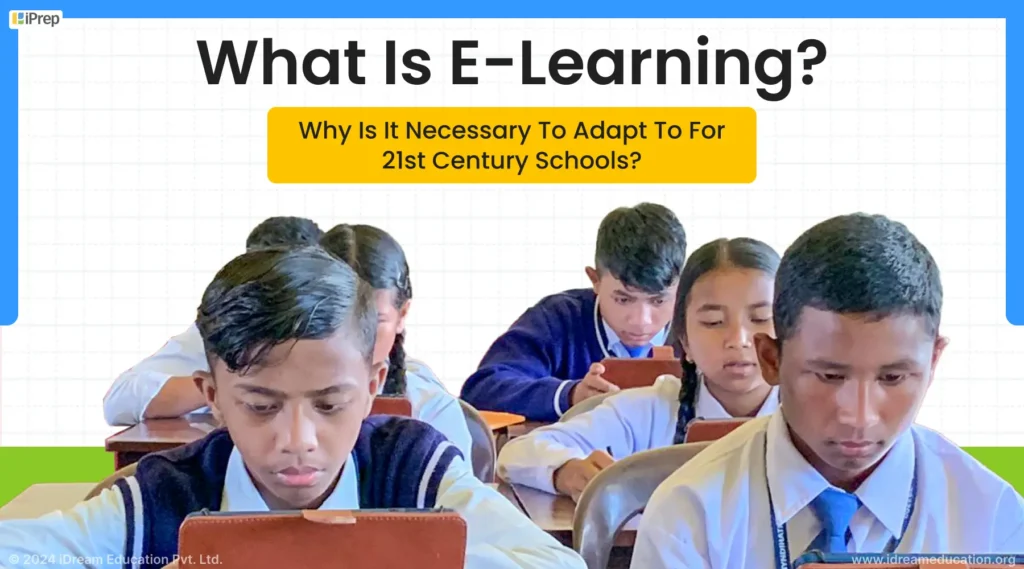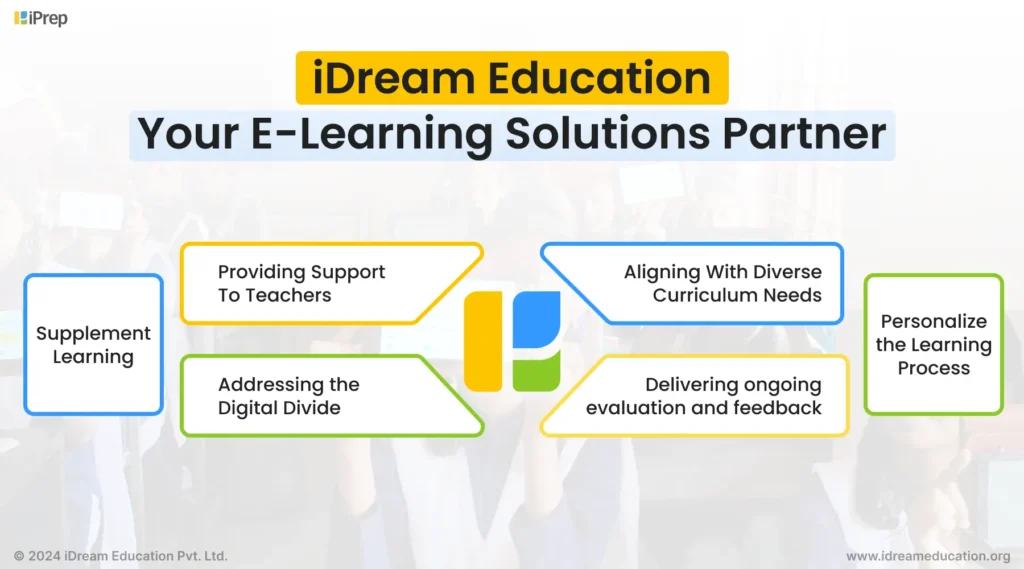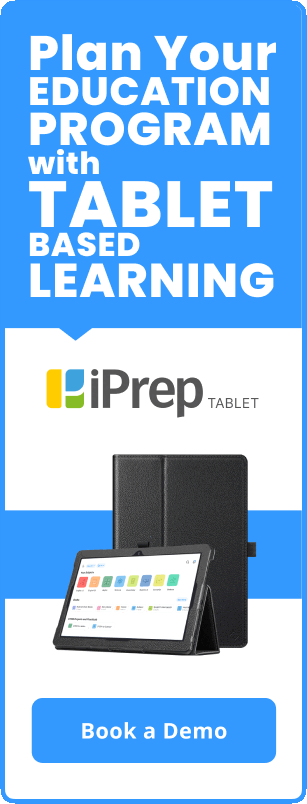What Is E-learning For Schools? Why Is It Necessary To Adapt?

Within the last few decades, there have been various developments around us which were mostly around inventing electronic versions of various already existing practices. Letters shifted to E-mails, Currency notes shifted to UPI or digital payments, and super bazaars shifted to e-marketplaces. To be precise, almost every practice now has an “E” i.e. electronic touch to it. Today we are going to talk about a concept that has been quite heavily influenced by electronic or technological advancement, especially in recent years. Presenting e-learning, a cutting-edge method of teaching that makes use of digital technology to produce interactive, customizable, and easily available learning environments.
This blog post explores the importance of e-learning for schools in the twenty-first century by diving into its understanding and various types. We’ll start with building an understanding of what is E-learning and will then explore the manifold advantages of E-learning for schools, including the promotion of diversity, the development of critical 21st-century skills, and the encouragement of digital literacy and self-directed learning.
We’ll also introduce you to iDream Education, a top supplier of E-learning solutions for school students, committed to giving Indian students universal access to learning and growth. We aim to bridge the digital divide, personalize the learning experience, and assist instructors and students in their educational journeys through our cutting-edge platforms, such as iPrep and iPrep PAL.
Come along with us as we explore e-learning for schools and uncover its potential to revolutionize education and enable the upcoming generation of learners. Let’s start with the basics.
What Is E-Learning?
Electronic learning, or e-learning, is the term for delivering instructional materials and learning support through digital technology and electronic devices. Through a range of electronic devices, including computers, tablets, and smartphones, learners can access instructional resources at any time and from any location, in contrast to traditional classroom-based learning. To accommodate a variety of learning styles and preferences, it includes a broad range of forms, such as interactive modules, videos, e-books, audiobooks, simulations, and a lot more.
Even though the phrase “e-learning” didn’t exist until 1999, its history is considerably older. Early e-learning methods included radio broadcasts and mail classes, which date back to the 19th century. But the real progress started in the 1960s with the creation of PLATO, the first computer-based learning system, and the growth of ARPANET, the forerunner of the internet. The personal computer revolution of the 1980s brought education right into homes and set the stage for the boom of e-learning in the 1990s with the introduction of multimedia PCs and the creation of the word “e-learning” itself.
The dot-com boom of the early 2000s contributed to the growth of online learning platforms and content. Richer multimedia content was made available by Flash video in 2005, and interactive and collaborative learning experiences were made possible by the emergence of Web 2.0 in 2004. By 2008, the mobile web had completely changed accessibility, enabling students to access courses and learning resources while they were on the go. The e-learning landscape we see today results from the adoption of HTML5, which in 2010 gave e-learning platforms a more stable and standardized base.
What About E-Learning For Schools?
E-learning for schools in India is a relatively new concept, with initial efforts dating back to the early 2000s. These involved government entities providing online classes, but limited internet connectivity slowed wider acceptance. The situation began to evolve in the late 2010s, as internet access became more affordable. Government measures such as the National Education Policy 2016 began to promote the use of technology in education. However, it was the COVID-19 pandemic that pushed e-learning ahead in schools. With physical classrooms shuttered, schools quickly used online tools to keep education going, paving the path for a more integrated future of e-learning in Indian schools.
What’s The Reality of E-Learning Today?
These days, e-learning for schools or students’ self-use comes in multiple forms, from gamified learning experiences and immersive virtual reality simulations to traditional lectures given online. Due to its potential to provide flexibility, personalization, and scalability that traditional techniques frequently find difficult to match, it has become an essential component of education, training, and professional development. We may anticipate that e-learning will advance more in sophistication, engagement, and accessibility as technology develops, influencing how people learn and receive education in the future. Now let’s gain an understanding of some of the most common types of e-learning for schools that we usually witness around us.
What Are Some Common Types of E-learning For Schools?

The term “e-learning” refers to a broad spectrum of instructional strategies. Here’s an overview of some common types:
Learning apps: These are mainly smartphone applications for learning that provide microlearning experiences in manageable portions. They are ideal for quick, concentrated learning sessions while on the go. To keep students interested and motivated, they frequently use engaging content, and gamifications in the form of practice, simulations, badges, and points.
Smart Classrooms: These are mainly digital classroom solutions that use technology to improve the traditional classroom experience. These smart class solutions create a setting that is more engaging for students via interactive whiteboards, projectors, and student response systems, which enable dynamic presentations, teamwork, and real-time feedback.
ICT Labs: Information and Communication Technology Laboratories, or ICT Labs, are special learning environments that give students access to computers, laptops, or tablets so that students can access digital tools to
Learning Tablets: These are portable tablets created especially for learning. These usually come with pre-installed learning management systems, instructional applications, and ebooks. They are an invaluable tool for both classroom and individual learning because of their price and portability.
Virtual Learning: This refers to the use of online learning platforms to simulate traditional classroom settings. With online collaboration tools and video conferencing, students engage with teachers and other students in real time, providing a flexible substitute for traditional classroom settings.
Why Is E-Learning Important for Students in the Twenty-First Century?
The significance of e-learning for students in the twenty-first century is immense, given the distinctive skill set and requirements that this era imposes:
1. Preparing For The Digital World
The twenty-first century has seen an increasing dependence on digital tools and swift technological progress. E-learning provides students with fundamental digital literacy competencies, enabling them to navigate digital environments effectively, proficiently employ diverse technologies, and critically assess information encountered on the internet. This prepares them for success in a world where the majority of learning, communication, and even professions are heavily reliant on digital technology.
Learning apps such as iPrep take this a step forward. With the comprehensive learning content for classes 1 to 12 covering all topics, chapters, and subjects, it also has a set of holistic growth-related subjects that help students gain all-rounded growth. These involve subjects such as digital literacy, financial literacy, yoga, performing arts, life skills, and a lot more which help students not just prepare for the digital world but also help them find their calling by identifying their interests and building their passions.
2. Promoting self-directed learning
E-learning platforms frequently allow learners to establish their schedules and learning methods, thereby fostering flexibility and autonomy. By allowing students to independently access course materials and complete assignments, they are encouraged to develop self-directed learning and time management abilities. This enables them to assume responsibility for their education, a critical attribute for fostering continuous learning and adjusting to the perpetually evolving needs of the labor force of the future.
E-learning apps such as iPrep come with a completely non-judgemental and self-directed learning experience for the students. Every learner gets to learn at their own pace and from the material of their choice. The app has various types of learning content from video lessons, practice, notes, tests, and syllabus books. A learner can swiftly choose the one that suits their learning style and can start their limitless journey of learning.
3. Tailored learning experience
E-learning platforms can accommodate a wide range of learning patterns and individual requirements. By utilizing interactive components, gamified learning, and an extensive selection of learning resources at their disposal, students are empowered to interact with the subject matter in manners that strongly appeal to them. A personalized approach has the potential to augment comprehension, strengthen the retention of knowledge, and ultimately elevate learning outcomes.
Personalized adaptive learning platforms such as iPrep PAL can come in handy here as these first diagnose the current learning level of the learners and then accordingly design a personalized learning path for them. That way every student gets the ability to master every chapter of every subject at their own pace and in their style. This can be further helpful in eradicating
4. Ensuring accessibility and inclusivity
E-learning surpasses the constraints of geography, thereby affording educational opportunities to students residing in remote regions or confronted with exceptional circumstances. Furthermore, by providing alternative learning formats and resources, it can accommodate students with varying learning abilities, thereby promoting inclusive education and guaranteeing that all individuals have access to high-quality educational experiences.
5. Developing 21st Century Skills
E-learning platforms frequently incorporate collaborative exercises, virtual discourse, and avenues for peer engagement. Cultivating essential 21st-century competencies including collaboration, critical thinking, problem-solving, and communication, prepares students to confront the challenges that will arise in an interconnected and globalized society.
That is why the e-learning app iPrep, together with its comprehensive set of learning content, brings a highly joyful yet knowledgeable beyond academics section. This section has subjects like digital literacy, financial literacy, sports, life skills, performing arts, and a lot more. With videos and notes on these subjects, iPrep as a one-stop solution helps students develop the skills that are necessary in the 21st century.
6. Enhancing Student Engagement
Compared to traditional lectures, E-learning is more dynamic and engaging thanks to the use of multimedia resources like films, simulations, and interactive components in e-learning systems. This can enhance the general learning process, motivation, and focus of students.
E-learning apps such as iPrep come with highly engaging and interactive learning resources that are sure to enhance the engagement levels of students in both classrooms as well as self-study. This includes video lessons, practice with instant feedback, simulations, interactive lessons, animated practicals, and a lot more. All these are sure to add to the engagement levels and make classrooms more efficient.
7. Real-world Application
E-learning provides students with tangible examples and simulations that bridge the gap between theoretical concepts and real-world applications. Through interactive modules and multimedia resources, students can directly engage with practical scenarios related to their studies. This immersive experience helps solidify their understanding of how academic knowledge translates into everyday situations, fostering a deeper grasp of the subject matter.
iDream Education: Your E-Learning Solutions Partner
iDream Education is a reputable provider in the ever-evolving realm of e-learning, specializing in meeting the unique requirements of K-12 pupils in India. Recognizing the distinctive opportunities and challenges of the twenty-first century, our mission is to furnish students with the knowledge, abilities, and self-assurance necessary to flourish in this perpetually changing global landscape.
Our iPrep platform comes in various formats of all-inclusive e-learning solutions designed to:
Supplement Learning
Our learning app solution, the iPrep App can be used by the students as a supplement to their self-study or classroom learning through the provision of interactive and thought-provoking learning experiences that accommodate a wide range of learning styles and encourage independent study.
Personalize the Learning Process
The iPrep PAL solution, which is a personalized adaptive learning app employs an adaptive learning technology to tailor the educational trajectory of every student, guaranteeing that they are simultaneously stimulated and assisted at a tempo that suits them.
Addressing the Digital Divide
Acknowledging the diversity in India that also goes on to differentiated access to the basic amenities, a significant digital divide isn’t just expected but also reflected in a lot of evidence in the form of social surveys. There are still a lot of places in our country that are deprived of such basic amenities that expecting the presence of mobile phones or computers in those areas is far from practical. Neither, can we expect a consistent supply of electricity in those areas that can ensure optimal use of computer devices as well as internet connections. That is why we provide offline content accessibility via pen drives and SD cards. It thereby enables uninterrupted learning in regions where internet access isn’t stable. Also, our tablet-based digital library solution, with just one hour of consistent electricity required for charging, can deliver learning experiences for 8 to 10 hours.
Providing Support To Teachers
Together with our E-learning solutions, we provide specialized teacher training and support to assist instructors in seamlessly incorporating technology into their instructional methods. By doing so, they can maximize the capabilities of iPrep, which enhances their pedagogical abilities and cultivates a cooperative learning atmosphere.
These teachers are then able to Incorporate multimedia components, gamified learning experiences, and interactive exercises into their teaching instruction, making learning Joyful for the learners. Thus it boosts student engagement which is a primary requirement for a teacher.
Aligning With Diverse Curriculum Needs
The learning content on iPrep is designed to accommodate the diverse educational environments in India by being aligned with multiple state boards and dialects. This ensures that students have access to accurate and pertinent learning materials.
Delivering ongoing evaluation and feedback
The platform incorporates assessment tools and reports that are seamlessly integrated. This enables both teachers and learners to monitor advancements, pinpoint areas that require development, and further customize the educational experience.
The iDream Education is an organization that is committed to innovation, quality, and accessibility. Its mission is to promote the provision of high-quality education to students, teachers, and institutions throughout India to cultivate a passion for learning and equip them with the necessary skills to thrive in the digital era.
Let’s Conclude
The development of e-learning is bound to have an ongoing impact on education in the future. E-learning platforms will become progressively more advanced, engaging, and personalized as technology develops, completely changing the way we teach and learn. At iDream Education, we dedicate ourselves to leading this change. We aim to provide students with the skills and information necessary to succeed as global citizens in the twenty-first century. Come along on this thrilling adventure with us and discover how e-learning may help you unlock the full potential of your endeavor.
iDream Education is eager to assist you on your e-learning journey, whether you are a student in search of a personalized learning experience, a teacher aiming to improve your teaching methodologies, or a school seeking a comprehensive e-learning solution.
Reach out to iDream Education right now to find out how our solutions can revolutionize your educational institution and enable your students to realize their greatest potential.







